Nancy Batson Crews | |
|---|---|
 | |
| Born | February 1, 1920 |
| Died | January 14, 2001 (aged 80) |
| Spouse(s) | Paul Crews |
Nancy Batson Crews (1920-2001) was one of the original women to participate in the Women's Auxiliary Ferrying Squadron (WAFS) during World War II.
Nancy Batson Crews | |
|---|---|
 | |
| Born | February 1, 1920 |
| Died | January 14, 2001 (aged 80) |
| Spouse(s) | Paul Crews |
Nancy Batson Crews (1920-2001) was one of the original women to participate in the Women's Auxiliary Ferrying Squadron (WAFS) during World War II.
Crews was born to Stephen and Ruth Batson in 1920 and she was one of four children. [1] Crews considered herself very fortunate to be born into an upper-middle-class family, as well as, parents that allowed her to be outside the Southern belle ideal. Her mother instilled Southern values but allowed Crews to be who she wanted to be. She wanted to fly since she saw Charles Lindbergh in Birmingham. Additionally, Crews was an excellent athlete during her youth, she participated in horseback riding and golf. During high school, Crews was on the cheerleading team. At the University of Alabama, Crews was elected to the highest coed office. [2] In 1941, she graduated from University of Alabama. [1] On February 1, 1946 she married Paul Crews and together they had three children, Paul, Radford, and Elinor. Finally, what was originally believed to be pneumonia was actually lung cancer which caused Crews' death on January 14, 2001. [2]
In August 1943, WAFS was changed to WASP. [2] [Women Airforce Service Pilots] (WASP) was created because Col. William H. Tunner commander of the Ferrying Division needed so many ferry pilots that he was willing to allow trained women to perform the job. [1] In 1944, Crews graduated from pursuit school. Crews' assignment was to ferry P-47s from the factory to embarkation points to later be moved to war zones. She often would travel one coast to the other at heights up to four miles high at three hundred miles per hour. She was one of the first twenty-eight women to pilot a United States plane in World War II. [2]
While Crews stopped flying between 1949 and 1959 because her children were young, she continued to fly for most of her life. [1] During the 1960s, Crews and her Super Club created a flying business. Through her business, she learned to how fly gliders and later became an instructor. In her seventies, she created a land and home development business. [2] She was the first president of WAFS post-war organization between the year 1972–1975. Additionally, she was elected mayor of California City for one term in 1978. Also, she served one term as the St. Claire County Airport Commissioner. [1] At seventy-nine, Crews co-piloted a corporate turbojet for almost eighty hours. [2]
In 1989, Crews was inducted into the Alabama Aviation Hall of Fame. In 1997, a plaque with her name was placed outside of Forest of Friendship. In 2004, she was inducted into the Alabama Women's Hall of Fame. [1] Finally, on March 10, 2010 Crews and the WASPs as a whole received a Congressional Gold Medal. [3] Crews' uniform, Mooney Mite, and first logbook are kept at the Southern Museum of Flight in Alabama. [1]

Jacqueline Cochran was an American pilot and business executive. She pioneered women's aviation as one of the most prominent racing pilots of her generation. She set numerous records and was the first woman to break the sound barrier on 18 May 1953. Cochran was the wartime head of the Women Airforce Service Pilots (WASP) (1943–1944) which employed about 1000 civilian American women in a non-combat role to ferry planes from factories to port cities, and was later a sponsor of the Mercury 13 women astronaut program.

Nancy Harkness Love, born Hannah Lincoln Harkness, was an American pilot and commander during World War II. She earned her pilot's license at age 16. She worked as a test pilot and air racer in the 1930s. During World War II she convinced William H. Tunner to look to set up a group of female pilots to ferry aircraft from factories to air bases. This proposal was eventually approved as the Women's Auxiliary Ferrying Squadron. Love commanded this unit and later all ferrying operations in the newly formed Women Airforce Service Pilots. She was awarded the Air Medal for her work during the war and was appointed lieutenant colonel in the US Air Force Reserve in 1948.
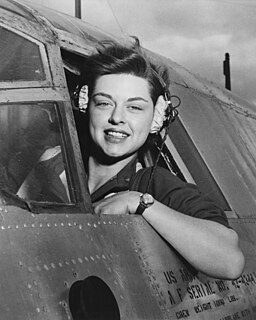
The Women Airforce Service Pilots (WASP) was a civilian women pilots' organization, whose members were United States federal civil service employees. Members of WASP became trained pilots who tested aircraft, ferried aircraft, and trained other pilots. Their purpose was to free male pilots for combat roles during World War II. Despite various members of the armed forces being involved in the creation of the program, the WASP and its members had no military standing.

Cornelia Clark Fort was a United States aviator who became famous for being part of two aviation-related events. The first occurred while conducting a civilian training flight at Pearl Harbor on December 7, 1941, when she was the first United States pilot to encounter the Japanese air fleet during the Attack on Pearl Harbor. She and her student narrowly escaped a mid-air collision with the Japanese aircraft and a strafing attack after making an emergency landing.
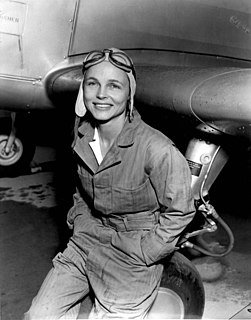
Betty Gillies was an American aviator, and the first pilot to qualify for the Women's Auxiliary Ferrying Squadron, later amalgamated into the Women Airforce Service Pilots.
Evelyn Genevieve "Sharpie" Sharp was an American aviator.
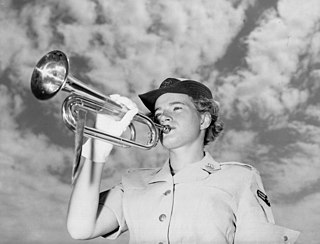
Women in the Air Force (WAF) was a program which served to bring women into limited roles in the United States Air Force. WAF was formed in 1948 when President Truman signed the Women's Armed Services Integration Act, allowing women to serve directly in the military. The WAF program ended in 1976 when women were accepted into the USAF on an equal basis with men.

Aline "Pat" Rhonie Hofheimer Brooks was an American aviator. Rhonie had several firsts as a pilot and was one of the pioneering women aviation pilots in World War II. She became one of the first members of the Women's Auxiliary Ferrying Squadron (WAFS). Rhonie also drove an ambulance in France. Rhonie is also known for her aviation history mural which is now located at Vaughn College of Aeronautics and Technology.
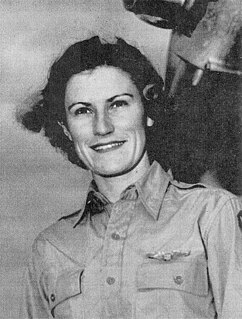
Iris Cummings, also known by her married name Iris Critchell, is an American aviator and former competition swimmer who represented the United States at the 1936 Summer Olympics in Berlin, Germany. After an active athletic career in swimming, which included a reign as U.S. national 200-meter breaststroke champion from 1936 to 1939, she was accepted into the University of Southern California's first Civilian Pilot Training Program in 1939. After graduation, she worked as a flight instructor prior to being selected to serve her country during World War II as a member of the Women's Auxiliary Ferrying Squadron (WAFS) and Women Airforce Service Pilots (WASP). Following the conflict, she returned to California, where she developed and taught a curriculum on civilian flight for veterans returning from the war at the University of Southern California.
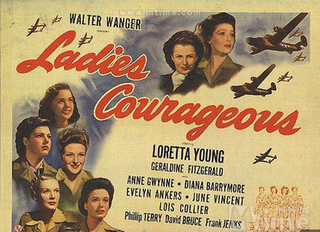
Ladies Courageous is a 1944 war film based on the novel Looking For Trouble (1941) by Virginia Spencer Cowles. Directed by John Rawlins, the film stars Loretta Young and Geraldine Fitzgerald. It tells the story of the paramilitary Women's Auxiliary Ferrying Squadron formed in the United States during World War II. Film historians and scholars consider Ladies Courageous an à-clef story of famed aviator Jacqueline Cochran and test pilot Nancy Harkness Love's work to mobilize women pilots to contribute to the war effort.
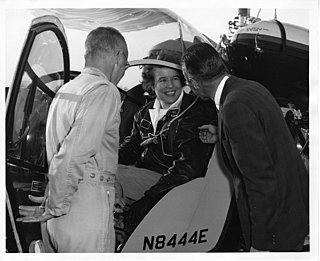
Dr. Dora Jean Dougherty Strother was an American aviator best known as a Woman Airforce Service Pilots (WASP) and B-29 Superfortress demonstration pilot. She was a U.S. military pilot, human factors engineer with Bell Aircraft, instructor at the University of Illinois and helicopter test pilot for Bell Aircraft.
Mojave Desert News is a newspaper published in California City, California. Named after the Mojave Desert, it reports on news in Kern County. Founded in 1938, it claims to be the longest-running newspaper in the east of the county.

Elaine D. Harmon was an American from Maryland who served in the U.S. Women Airforce Service Pilots (WASP) during World War II. In 2009 she received a Congressional Gold Medal for her service as a pilot during World War II. As a WASP pilot, she has been accorded full military honors at Arlington National Cemetery. In 2016, Ms. Harmon was posthumously inducted into the Maryland Women's Hall of Fame.
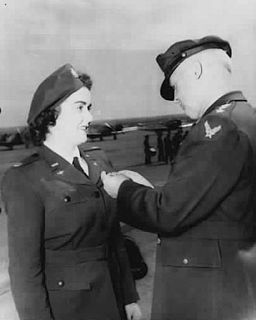
Barbara Erickson London was a Women Air-force Service Pilot (WASP) and a member of the Women's Auxiliary Ferrying Squadron (WAFS). She was a ferry pilot – picking up and delivering various military aircraft to and from factories and airbases throughout the United States. She won the Air Medal, and was the only woman awarded one in World War II.

Hazel Jane Raines was an American pioneer aviator and flight instructor with the Civilian Pilot Training Program. During World War II, she was part of the first group of United States women to fly military aircraft, which they did in a war zone for the civilian British Air Transport Auxiliary. She was later a member of the civilian contract labor Women Airforce Service Pilots. After the war, she taught instrument training in Brazil. When President Harry S. Truman authorized the integration of women into the military, she served with Women in the Air Force and was based in Texas, Alabama, and finally London until her death. Raines was the first woman in Georgia to earn a pilot's license, and has been inducted into both the Georgia Aviation Hall of Fame and the Georgia Women of Achievement.
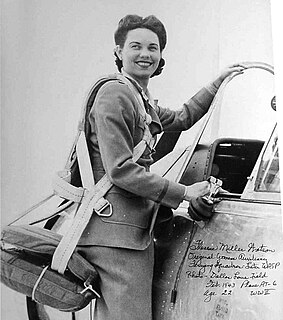
Florene Miller Watson was an American aviator and educator from Texas. Watson was one of the first Women's Auxiliary Ferrying Squadron (WAFS) volunteers. She went on to fly for the Women Air Force Service Pilots (WASP) throughout World War II. During that time, she worked as a trainer, ferried aircraft and was a test pilot.

Teresa D. "Jamesy" James was an American aviator. James was one of the first Women Airforce Service Pilots (WASP) pilots, starting out as part of the Women's Auxiliary Ferrying Squadron (WAFS) in 1942. James was also known as a stunt pilot and later became a Major in the Air Force Reserves. James flew most of her life and fought for military recognition for the WASP.
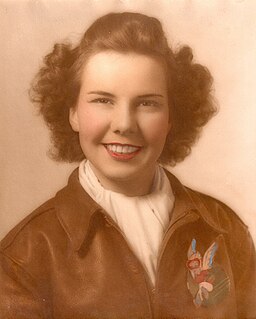
Dorothy Eleanor Olsen was an American aircraft pilot and member of the Women Airforce Service Pilots (WASPs) in World War II.

Rosa Gerhardt was an American attorney from Mobile, Alabama, where she served as president of the Mobile Bar Association, the first woman in Alabama to hold the position at a local or state bar association.

Adela "Del" Riek Scharr was an American aviator. Scharr was the first woman in St. Louis to earn her commercial flight license and worked as a flight instructor at Lambert Field. Scharr was recruited in 1942 to join the Women's Axillary Ferrying Squadron (WAFS) and later flew planes as a WASP. Scharr was also the first woman to fly a P-39 Bell Aircobra. After World War II, Scharr was commissioned as a major in the Air Force and also worked as a teacher.
{{cite web}}: Missing or empty |url= (help)